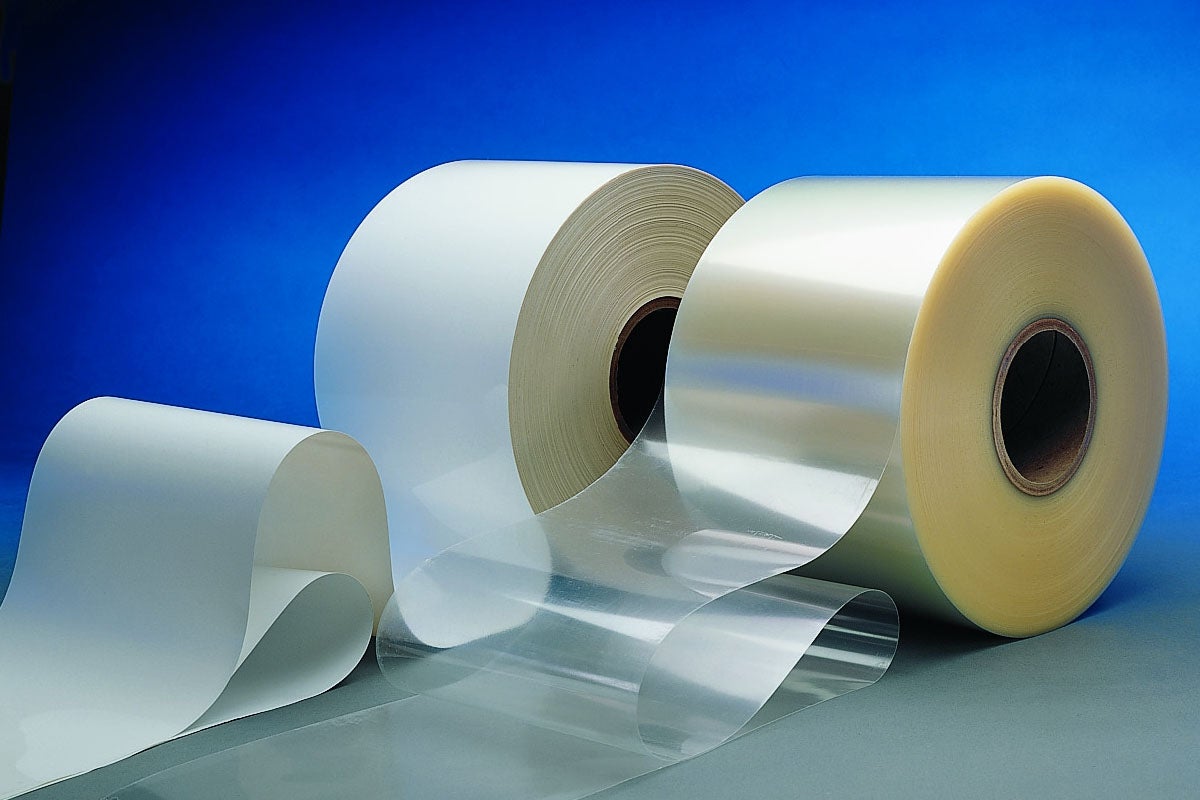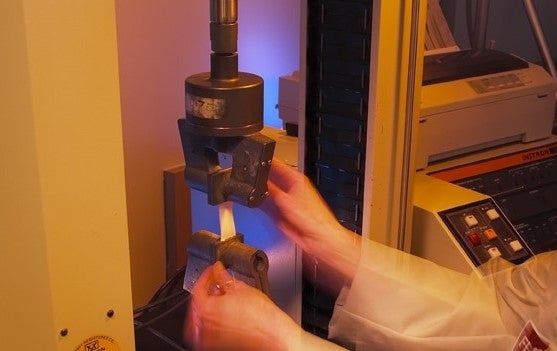Tech Tips
What’s the best film for your application?

Many factors weigh into selecting the most appropriate film for an application. It’s necessary to think about printing method, die cutting, and durability requirements along with the necessary levels of conformability and dimensional stability. Other characteristics such as gloss, clarity and cost can also drive substrate selection. Often, the correct combination of film and application surface will dictate an application’s ultimate success.
Start with the performance requirements of your application. Is the surface curved or flat? Will the product spend most of its life inside or outside? How about exposure to chemicals, moisture, and temperature extremes? Must the product survive repeated deformation or flexing? The answers to these questions will determine the critical properties of the film to ensure application success.
This article will examine the key attributes of film and the advantages and disadvantages of some of the more popular film types.
Film Properties
Some of the critical properties Flexcon measures for film substrates include thickness, gloss, color, haze/optical density, surface energy, shrinkage, tensile strength and elongation, tear resistance, and handle. While many of these properties sound familiar, some merit additional explanation.
Surface energy is a surface characteristic associated with the molecular forces of the film’s interaction with another material. It gives an indication of how well liquids (adhesives, inks, etc.) will wet out on the surface of the material. It is measured by measuring either wetting tension or contact angle. These measurements involve observing the behavior of liquids placed on the film’s surface - dynes solution in the case of wetting tension, or water in the case of contact angle.
Shrinkage is a measure of the dimensional change of a film when exposed to heat. Sometimes there are also visual changes that occur as films shrink that could make the appearance undesirable to the end user of the product.
Tensile strength, measured in pounds per square inch, indicates the force required to elongate the material. Elongation is measured at the same time as tensile strength and tells us the ability of the film to stretch without breaking. For example, 100 percent elongation means that the film can be stretched to twice its original length before breaking.
Tear resistance can be measured in two ways: tear initiation and tear propagation. Tear initiation measures the force required to start tearing the film, whereas tear propagation measures the force required to continue a tear that already exists.
Handle shows the flexibility of the film. A higher handle value means a stiffer film and less ability to conform to curved surfaces.
Haze and Opacity. The haze of a clear film is measured by passing light through it and measuring the amount of light that scatters more than 2.5 degrees. The lower the haze number, the closer the film is to appearing “glass clear”. Haze can be caused by surface roughness or by internal composition of the material. For white and colored films, we measure opacity or optical density. Higher numbers here indicate lower light transmission through the film (i.e. greater opacity).
Key Attributes of The Most Popular Films
PET (Polyester) - Common usage - durable goods labels
This biaxially oriented film is available in gauges ranging from 0.5 mil to 10 mil. PET is most often available in clear, clear matte, and white. Silver and silver matte versions can be manufactured by vacuum depositing aluminum on clear or clear matte films, known as metalization.
PET is dimensionally stable at high temperatures and offers durability in the form of excellent initial tear and puncture resistance. It provides good thermal and chemical resistance as well. PET is also available topcoated or print treated to enhance printability.
Produced to very high standards, polyester is an extremely smooth substrate that lends itself well to applications that require good adhesive wet out. In addition, it offers an even caliper across the web. Polyester also retains good optical clarity over a wide range of temperatures, making it an ideal choice as an overlaminating film. A non-reactive substrate, polyester bonds well with many inks, coatings, and adhesives.
Polyester withstands many outdoor stresses, such as temperature extremes, environmental conditions and exposure to moisture. It is an ideal choice for material tracking labels as well as compliance, product identification, and safety/hazard/instructional labeling for durable goods. It can also be used for two-way window decals inside of storefront windows.
PVC (Vinyl) - common usage - outdoor graphics
Vinyl comes in gauges ranging from 2 mil to 12 mil and offers a great degree of conformability and flexibility, making it ideal for applications involving compound curves. Cast vinyl is available in black, white, and clear. Calendered vinyl also comes in black, white, clear, and a wide range of other colors. An extremely malleable film, vinyl can be easily embossed to create unique textures. Vinyl is also easy to print.
Vinyl is generally very weatherable, offering good resistance to UV light and exposure to other environmental conditions. It is therefore often used for outdoor applications. However, vinyl can become brittle at very low temperatures and soft at very high temperatures.
Cast vinyls are most commonly used for fleet graphics, but calendered vinyls are growing in popularity for this application. Calendared vinyls are ideal for product identification and safety/hazard/instructional labeling for durable goods. Calendered vinyl can also be used for indoor applications, such as short run temporary P-O-P, as well as holiday/seasonal and novelty stickers, bumper stickers and college, alumni and association decals. Vinyl can be perforated to create one-way-vision transit advertising and window graphic applications. A reliable and durable substrate, vinyl is also a popular choice for wall murals and billboards.
PP (Polypropylene) - common usage – consumer labeling
Polypropylene is usually produced in clear, clear matte, white, or silver (metallized). Like polyester, polypropylene is frequently a biaxially-oriented film. Polypropylene also exhibits excellent chemical resistance and can withstand exposure to a variety of container contents.
Polypropylene is produced in substantial volume for non-pressure-sensitive applications in the snack food industry, such as bags, wraps, and other flexible packaging. The high-volume production of polypropylene makes it a very economical film. This economy of scale has helped drive the success of this substrate in the pressure-sensitive label market, especially as an alternative to paper labels.
Polypropylene can be topcoated and surface treated to enhance its printability. This has helped make it a popular choice for consumer labeling applications requiring the no-label look, such as with food and beverage (particularly glass bottle), personal care, household/chemical, and pharmaceutical. It is well suited for semi-squeeze and rigid containers. PP is primarily recommended for interior applications.
PE (Polyethylene) - common usage – flexible container labeling
Available primarily in clear, clear matte and white matte, but also in metallized, polyethylene comes in gauges ranging from 1.5 mil to 4 mil. PE features excellent chemical resistance and can withstand exposure to container contents. It is often produced by either being blown or cast extruded. The blown version is stiffer than a cast product, while the cast version is a non-oriented, flexible substrate ideal for applications that require extreme deformability or squeezability.
High-density polyethylene is usually very durable, featuring excellent stiffness and moderate elongation. This makes it relatively easy to dispense, but it tends to have more gels and imperfections than the medium-density version. These imperfections can lead to printing challenges. Today, however, suppliers are offering many medium-density/high-density blends to achieve the best of both worlds. There is also substantial research into metallocene technology, which involves the manipulation of the polymers in different configurations and shapes to produce stronger, clearer polyethylene films.
Specialty Films
Other high-performance films offering premium characteristics are also available. These films can offer an enhanced level of performance to meet specific needs.
Polycarbonate – Available in gauges ranging from 3 mil to 15 mil, polycarbonate is a durable film. It is dimensionally stable, and typically offered with a clear velvet embossed surface, providing excellent scratch resistance.
Typical uses include graphic overlays on membrane switches, as well as backlit signage where one side of the sign is exposed to UV light and the other is exposed to elevated heat due to the interior lighting. It is also ideal for applications that require repeated actuations or constant usage.
Instrument panels and dial gauges often use thicker sheets of polycarbonate. In these cases, the graphics are often subsurface-printed and a transfer tape is then used to mount the graphic to the application surface.
Acrylic – Clear and white acrylic substrates are available in 1.5 mil and 2 mil versions. Acrylic offers UV resistance as well as excellent outdoor durability. It features good tensile strength and is often relatively rigid. The clear version is often used as an overlaminate. Both clear and white can be used for outdoor signage applications.
Other Films
Specialty films, such as Tyvek*, polyimide films, and fluoropolymers are used for unique applications.
Tyvek (spun bound olefin fiber) features a coarse surface, excellent dimensional stability, and tear resistant characteristics. Lightweight and durable, Tyvek has introduced new dimensions of protection, security and safety in a wide variety of industries. It can be slit, scored, die-cut, laminated, embossed, grommetted and sewn, making it extremely versatile.
High-temperature polyimide constructions are ideal for high-temperature labeling applications, such as printed circuit boards where the wash cycle subjects the labels to extreme heat and volatile chemicals. However, polyimide has a natural amber color, so the addition of a white coating is necessary to make it suitable for this purpose.
Fluoropolymers offer extended UV protection, anti-graffiti, chemical resistance and protection from moisture, scratching and dirt, making them an excellent choice for overlaminating durable labels.
Laminations
Laminations, which combine the characteristics of two or more substrates, are also available. For example, a polyester/vinyl laminate offers the durability of polyester and the conformability of vinyl. They can be used for applications where a thicker substrate is required.
Make The Right Choice
Choosing the right substrate for your application involves understanding both the converting and end-use requirements. The success of the application hinges on understanding these factors and then matching a product to those needs.
*Tyvek is a registered trademarks of E.I. DuPont Company
